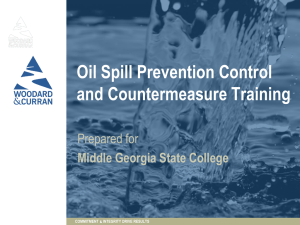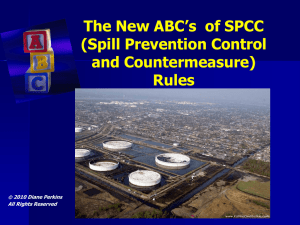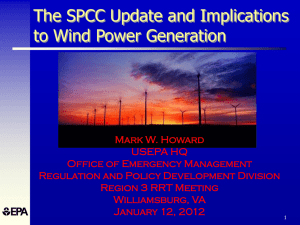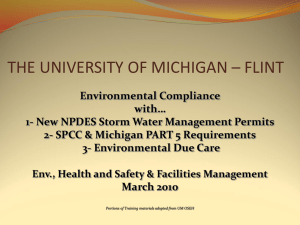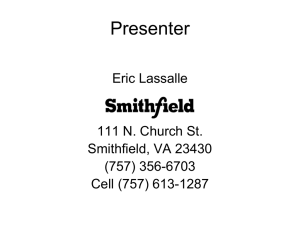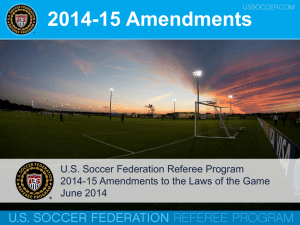U.S. EPA Oil Spill Program
advertisement
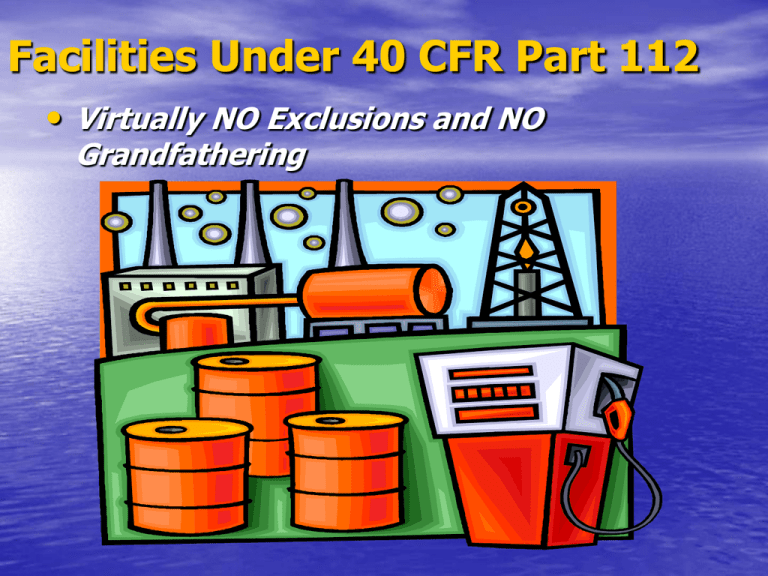
Facilities Under 40 CFR Part 112 • Virtually NO Exclusions and NO Grandfathering What’s in a name? • Spill • Prevention • Control = • Countermeasure SPCC Who Must Comply? • All bulk facilities that: • • • • – Store petroleum products – Have 1320 or more aggregate gallons of above ground storage – counting all containers 55 gallons or greater. Any cargo tank truck parked overnight in a lot containing more than a “residue” of oil. Biodiesel and ethanol tanks Farmers Skid tanks – if aggregate capacity is over 1320 Who is Exempt? • An underground storage tank facility that: – Has no aggregate above ground storage of 1320 gallons or more, and – Complies with all state and federal UST regulations. • A lube oil warehouse using containers less than 55 gallon capacity. • Card Lock with no AST capacity of 1320 or more. SPCC – Brief History • • • • • • • • • • • 1973 2002 2003 2003 2004 2004 2006 2006 2007 2009 2010 – EPA issues first SPCC rule – EPA issues revised SPCC rule – EPA Sued by PMAA – EPA extends SPCC compliance date – EPA amends new SPCC rule (PMAA settlement) – Compliance dates extended again – EPA amends 2002 SPCC rule – Compliance dates extended again – EPA amends 2002 SPCC rule – Final SPCC revisions issued - Compliance deadline for the last time! Why All the Changes? • It’s a big universe of tanks and components – one does not fit all. • EPA goofed – failed not conduct small business cost-benefit analysis on many provisions in the SPCC rule. • Changing regulatory philosophy. – Clinton to Bush era Why the Amendments are a Good Thing. • Compliance Flexibility – Alternative procedures for compliance that are “environmentally equivalent” (PE). – Significant discretion to select compliance methods (owner/operators). • General secondary containment methods. • Tank inspection. • Facility security measures. • Compliance Cost Savings. Why are the Amendments a Good Thing? • Flexibility – Clarification of the term “Loading Rack” for purposes of complying with SPCC. – Simplified SPCC plans for bulk plants with 10,000 gals or less aboveground storage. – Streamlined tank integrity testing for shop erected tanks under 30,000 gallons. – Flexible security requirements for bulk plants. – Regulatory relief from secondary containment. requirements for parked trucks. – Do-it-yourself tank inspection. Preparing an SPCC plan – Who does it? • The owner/operator of the facility is ultimately • responsible for preparing an SPCC plan. • You can draw up your own SPCC plan But ……… • A professional engineer (PE) must review, certify and sign it. • Most PE’s do the whole thing. • Exception – Tier I Tanks – Tier II Tanks SPCC Plan – What’s in it? General Requirements: • General facility description (words and diagram) • Description of all spills within the past 12 months. • Spill predictions – direction, rate of flow, quantity. • Containment and diversionary structures • Alternative oil spill contingency plan. SPCC PLANS – The Specifics • Goal is to Stop Oil Spills - Provide sized secondary containment – Planning for catastrophic leaks – containing the capacity of the single largest bulk plant or cargo tank compartment. – Bulk tanks and loading racks Dike or Remote Impoundment capable of containing the capacity of the single largest tank plus freeboard. Earth or concrete. SPCC PLANS – The Specifics – Provide General Secondary Containment – Planning for the “most likely” leak small leak around a valve, hose coupling or fitting. – – – Transfer piping, couplings, hose connections Parked trucks containing product. Anywhere oil is transferred and there is no sized secondary containment SPCC PLANS – The Specifics • General secondary containment (cont.) – Active measures – requires deployment of equipment. • Absorbents. • Booms or other portable containment devices. – Passive measures. – requires permanent installation of equip. • Drip pans SPCC PLANS – The Specifics • Testing and Inspection – Periodically inspect pipes and containers • Visually for above ground pipes and tanks on saddles or racks • Leak test buried pipes when installed or repaired • Integrity test tanks sitting on pads. • How? Use Industry Standards SPCC PLANS – Written Plans • Develop and implement a written SPCC plan that describes: – Oil handling operations. – Spill prevention practices. – Discharge or drainage controls. – Personnel, equipment and resources at the facility that are used to prevent oil from reaching navigable waters. SPCC PLANS- Written Plans • Elements of a written plan – Operating procedures to prevent spills. – Control measures (containment) to prevent oil from reaching navigable waters. – Counter measures to clean up and mitigate spills that reach navigable waters. SPCC PLANS – Attachments • Attach to the written SPCC plan: - Plot Drawing of Facility. - Map location of Facility. - Certification of Substantial Harm Criteria Form. Basically any facility that stores over 42,000 gallons and does overwater transfers or any facility that stores over 1 million gallons near surface waters. SPCC Plan – The Whole Package • Elements of the SPCC plan – Facility diagram and description. – Oil discharge prediction. – Appropriate containment and diversion structures. – Facility drainage. – Site security. – Facility inspection. SPCC Plan - The Whole Package – Tank and piping inspection. – Oil transfer procedures and equipment. – Loading and unloading procedures. – Personnel training. – Record keeping. – Five year plan review. – Management approval. – PE certification. SPCC Amendments • New Compliance deadline. – All plans must be revised and all revisions must be implemented by 11/10/11 • (2002)Exempt UST facilities. – Exempts any UST facility 42,000 gallons or less of underground storage capacity or any aggregate capacity over 42,000 gallons which conforms with state and federal UST requirements. • Alternative methods of compliance. – Allows deviations in standards when equivalent environmental protection is provided along with justification (PE determines) SPCC Rule Amendments • New storage capacity threshold trigger. – Establishes an aboveground storage capacity threshold of more than 1,320 gallons and removes the 660 gallon minimum capacity triggering compliance with SPCC. • New minimum container size. – Exempts a container of less than 55 gallons from counting towards 1320 gallon threshold for compliance. SPCC Rule Amendments • (2002)New overfill requirements. – Requires Overfill Prevention systems & alarms to be installed in accordance with industry standards and applicable fire codes. – Overfill prevention must be inspected/tested at regular intervals. Audible vent whistles can be used at smaller tanks; or written directions for operator to watch tank gauges during filling. SPCC Rule Amendments • New buried piping requirements. – All buried piping that is installed or replaced after 8-16-02, must have protective coating and wrapping and cathodic protection. State standards may be stricter. • New loading rack requirements. – Loading racks must be equipped with sized secondary containment (“should” to “shall”) SPCC Rule Amendments • New facility diagram requirements. – The Facility diagram must include the location of the USTs, type of oil in each AST and size, surface flow, loading/unloading areas, & aboveground piping; • New streamlined security requirements – – – Tailor security to specific characteristics of site – no one size fits all approach. Owner operator discretion. Lighting and fencing no longer required if: SPCC Rule Amendments • Secure control access to the facility. • Secure master flow and drain valves. • Prevent unauthorized access to starter controls for oil pumps. • Address appropriateness of lighting to prevent vandalism and detect discharges. SPCC Rule Amendments • (2002) Review SPCC plan every five years instead of every three years. • Additional review only requires PE when EPA/Technical Amendments are made. Examples: - Addition/Deletion of tank. - Change in service of tank. - Change in spill potential of facility. SPCC Amendments • (2002)Secondary containment systems – – For bulk tanks, loading & unloading areas and piping systems must be “sufficiently impervious”. PE determines what constitutes sufficiently impervious using good engineering practices. SPCC Amendments • Secondary containment – sizing – – Includes freeboard allowance for rain. Sufficient freeboard allowance is a 25 year storm. • Employee training. • Now limited to oil-handling employees. • Records – Copy of SPCC plan must be at facility operated (manned) 4 hours a day (not 8). SPCC Amendments • Streamlined Integrity Testing – – Tank, piping & valves must undergo integrity testing at regular intervals & when repaired. – “The PE may use STI SP001 “Standard for the Inspection of Aboveground Storage Tanks for testing and inspection standards. For a copy contact STI, 944 Donata Court, Lake Zurich, IL 60047, phone-847/438-8265, www.steeltank.com SPCC Amendments • (2002)Integrity testing for tanks sitting on the ground or cement pad – Integrity testing that combines visual inspection with placement of a barrier between the container and the ground in a way that ensures that any leaks are immediately detected, is permitted in place of visual inspection plus some other form of integrity testing. EX. synthetic liner. SPCC Amendments • Integrity Testing Methods for tanks sitting on the ground continued. – Test or inspect each aboveground container for integrity on a regular schedule and whenever you make material repairs…. Examples of these integrity tests include, but are not limited to: visual inspection, hydrostatic testing, radiographic testing, ultrasonic testing, acoustic emissions testing, or other systems of non-destructive testing. SPCC Amendments • Integrity Testing for tanks on racks or saddles (PMAA Lawsuit): • Visual inspections alone are permitted where a shop built tank with a capacity of 30,0000 gal or less is elevated off the ground, in a manner that decreases corrosion potential and makes ALL sides and bottom of the tank visible for inspection. • Owners/operators may self inspect if using a methodology approved by a professional engineer SPCC Amendments Tank Integrity testing (cont) • Two methods of compliance –more flexibility. – You can use an EPA recommended methods such as API 653 or STI-SP001, OR – You can use an alternative method of compliance, (a method not included in the rule). 2008 SPCC Amendments • Tank Integrity Testing (cont.) – If you use a recommended method of compliance, you are not required to have the approval of a PE or a justification in your SPCC plan as to why this method is "equally protective of the environment". – If you use an alternative method of compliance, you must have approval of the PE and justification in your SPCC plan that the method is "as equally protective of the environment" as the recommended method of compliance that you are replacing. 2008 SPCC Amendments • New Definition of “Facility” – Owner/operator has discretion to which contiguous or non contiguous building or structures make up the “facility” – Allows owner/operator to separate or aggregate containers to determine facility boundaries and applicability of SPCC 2008 SPCC Amendments • New Definition of “Loading/unloading Rack” – “Loading/unloading rack” means a fixed structure (such as a platform or gangway)necessary for loading or unloading a tank truck or rail tank car that is located at an SPCC facility – Loading/unloading rack includes the loading arm and any combo of the following: – Piping, valves, pumps, shut-off devices, overfill sensors or personal safety devices. 2008 SPCC Amendments • Definition of Loading/unloading rack cont: – Equipment present at a loading/unloading rack where a pipe stand connects to a cargo tank vehicle or rail car is not considered a loading or unloading rack for purposes of compliance with SPCC regulations – The new definition clarifies the limits of the loading/unloading rack area where sized secondary containment is required SPCC Amendments • Tier I Facilities – Streamlined SPCC Plans for Bulk Plants with 10,000 gallons or Less Capacity and no Single Tank greater than 5000 gallons. – Owners/operators may draft and self certify SPCC plans or use a generic template. – Tier I facilities are not required to comply the following SPCC provisions: loading racks, facility diagrams or descriptions, brittle fracture. SPCC Amendments • Tier I Facilities (cont) – Evaluation, facility drainage, facility transfer operations, and effluent treatment facility – Involvement of a Profession Engineer is not required for Tier I facilities – EPA plan template for Tier I facilities can be downloaded at: – http//www.epa.gov/emergencies/content/spcc/index.htm SPCC Amendments • Tier II Facilities – Tier II facility is a bulk plant with 10,000 gal or less of storage with a single tank over 5000 gal y – Owner/operators are permitted to draft and self certify Tier II facility plans – However, any deviations from the SPCC provisions must be certified by a professional engineer – EPA template for Tier I facility may not be used SPCC Amendments • Security Requirements. – Revisions amend existing SPCC security requirements. – Security requirements may now be based on the individual characteristics of the site. – Facility fencing, 24-hour monitoring, lighting etc not required if: SPCC AMendments • Security Continued: – Secure and control access to oil handling, process and storage areas. – Secure master flow and drain valves. – Prevent unauthorized access to starter control and pumps. SPCC Amendments • Security Continued: – Secure out-of-service loading and unloading connections of pipelines, and – Address appropriateness of security lighting to prevent acts of vandalism and the discovery of oil discharges. – EPA will find any bulk plant out of compliance if owner does not use reasonable discretion in selecting security methods. SPCC Amendments • Parked Cargo Tank Vehicles – Not technically an amendment – new rule. – PMAA requested relief from sized secondary containment requirements for cargo tanks containing product parked overnight at bulk plant facilities. – Sized Secondary containment requires SPCC Amendments • Parked Cargo Tank Vehicles cont. – Containment of the volume from the single largest compartment of truck – Requires dikes and berms – Few comply with secondary containment for parked vehicles – EPA stepped up enforcement of this costly requirement – NEFI asked for regulatory relief SPCC Amendments • Parked Cargo Tank Trucks cont. – EPA agreed with NEFI and now allows for general secondary containment for parked cargo tank vehicles – General secondary containment requires only that the “most likely” release be addressed such as a leaky valve – Drip pans and absorbents not dikes and berms SPCC Amendments • Parked Cargo Tank Trucks cont. – EPA is not putting a limit on how long a cargo tank may be parked before it is subject to sized secondary containment as permanent storage. – Don’t push it! 2-3 days max then move it! Compliance Schedule • Bulk Plant Operators must revise SPCC plans and implement changes in plans no later than November 11, 2011. Where do I go from here? • Do not delay. • Find a professional engineer that specializes in SPCC. • Obtain any necessary permits from local government. • Line up contractors now. Where do I go from here? • REMEMBER! • The professional engineer has enormous flexibility regarding alternative methods for compliance. Methods that could save you time and money. Make sure you hire a PE that understands the built-in flexibility of the SPCC rule. Contact Information Mark S. Morgan, Esq. PMAA Regulatory Counsel (202) 364-6767 mmorgan@pmaa.org
